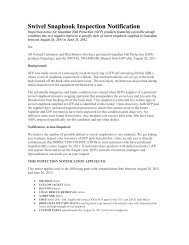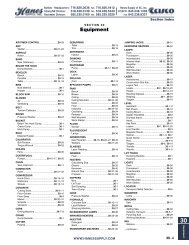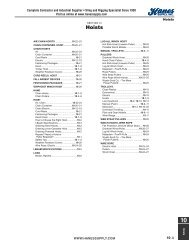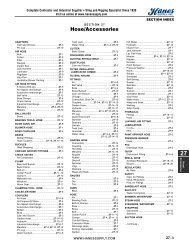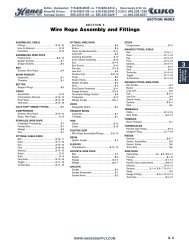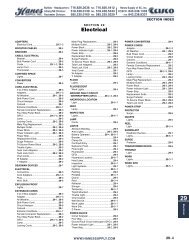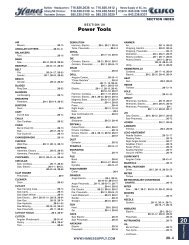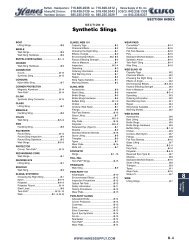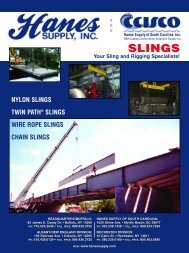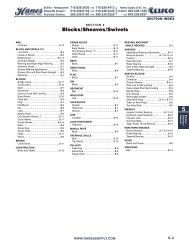YOUR SLING AND RIGGING SPECIALISTW<strong>in</strong>ch l<strong>in</strong>estHe Use of slInGs WItH a W<strong>Inc</strong>H lIneThe w<strong>in</strong>ch l<strong>in</strong>e itself should not be used as a choker to pick up apole or other objects. The hook attached on the end of the w<strong>in</strong>dl<strong>in</strong>e can cut deeply <strong>in</strong>to the rope itself. We recommend a separatel<strong>in</strong>e, sl<strong>in</strong>g or strap be used as the choker and not the basicw<strong>in</strong>ch l<strong>in</strong>e itself.booM sHeaVe RecoMMenDatIonsTo assure maximum efficiency and safety, the boom sheave diametershould be no less than eight (8) times the rope diameter.The sheave groove diameter should be no less than 10% greaterthan the rope diameter, and the groove should be round <strong>in</strong> shape– not V-shaped."DoUble block" sYsteMFor handl<strong>in</strong>g heavy loads (up to 14,880 lbs. – pad-mounted transformers,etc.) us<strong>in</strong>g 1" diameter Stable Braid w<strong>in</strong>ch l<strong>in</strong>es, withoutexceed<strong>in</strong>g R.W.L. of rope (7,440 lbs.), a Double Block System isrecommended.The system avoids the use of 1-1/4" diameter Stable Braid, whichlimits capacity of w<strong>in</strong>ch drum and/or sheave-size.Boom-tip w<strong>in</strong>ch drum(or sheave-lead<strong>in</strong>g frombase-mounted-w<strong>in</strong>ch)Derrick-boom-rated @ 14,520 lbs. max.(bare drum) – elevated @ 70°from horizontal.1" dia. rope(stable Braid)7,440 lb. RWL(one-leg)2-legs = 14,880 RWL –compatible with boommax. capacity: ie., Ropecannot be overloaded –beyond rope RWLeYe sPlIcInGEye splices at the end of w<strong>in</strong>ch l<strong>in</strong>es, (if not put <strong>in</strong> at the factory)should be done <strong>in</strong> strict accordance with the steps and proceduresManufacturers Splic<strong>in</strong>g Instructions under "Standard Eye Splice."This splice can be easily learned and executed by l<strong>in</strong>e crews andshop personnel. Assistance <strong>in</strong> splic<strong>in</strong>g <strong>in</strong>struction is availablethrough <strong>Hanes</strong> <strong>Supply</strong>. Tra<strong>in</strong><strong>in</strong>g Splic<strong>in</strong>g Kits, manuals, and toolscan be ordered through <strong>Hanes</strong> <strong>Supply</strong>.The Standard Eye Splice can't be pulled out under tension; it can,however, be pulled out by hand when <strong>in</strong> a relaxed state. To preventsuch tamper<strong>in</strong>g, it is recommended that stich lock<strong>in</strong>g or atight seiz<strong>in</strong>g be applied to the base or throat of the splice. Whensplic<strong>in</strong>g used rope, be sure to refer to the "Special Tips for Splic<strong>in</strong>gUsed Rope" <strong>in</strong> the Splic<strong>in</strong>g Manual.knotsSplic<strong>in</strong>g is, by far, the strongest and most efficient means of attachment.Knots should never be tied <strong>in</strong> a w<strong>in</strong>ch l<strong>in</strong>e if it can <strong>in</strong> anyway be avoided, as knots can reduce the strength of any rope (orwire) as much as 50%. Also, avoid sharp bends <strong>in</strong> the l<strong>in</strong>e wherepossible as this will also greatly reduce strength.stItcH lockInG eYe sPlIcesStitch lock<strong>in</strong>g may prove advantageous on some splices to preventno-load open<strong>in</strong>g due to mishandl<strong>in</strong>g.Material required – about one (1) fid length of Nylon Whipp<strong>in</strong>gTw<strong>in</strong>e approximately the same size as the strands <strong>in</strong> the size ropeyou are stitch lock<strong>in</strong>g. The same strands cut from the rope youare stitch lock<strong>in</strong>g may also be used, but whipp<strong>in</strong>g <strong>tw<strong>in</strong></strong>e is preferable.Instructions are <strong>in</strong> the Manufacturers Splic<strong>in</strong>g Manual.Boom drilled for eye-bolt(permanently <strong>in</strong>stalled) –to accomodate standardw<strong>in</strong>ch-l<strong>in</strong>e hook – asneeded.Removable Nylite "snatch-block" –stored <strong>in</strong> truck, for quick <strong>in</strong>stallationand removal – as needed.note: While the 2-legsystem does allow useof 1" dia. rope (vs 1-1/4"dia.) – it does require agreater length and results<strong>in</strong> slower lift<strong>in</strong>gspeeds.NOTE: Unless boom is equipped with "pole-grabber" claws – thissystem does not work well – when handl<strong>in</strong>g and sett<strong>in</strong>g poles – aspole can't be snubbed tightly aga<strong>in</strong>st jaws at end of boom.The result is that 1" diameter Stable Braid can be used – with as<strong>in</strong>gle leg, for most normal lift<strong>in</strong>g operations – (up to 7,440 lbs.) –and for heavy lifts up to 14,880 lbs.) us<strong>in</strong>g the double leg system– <strong>in</strong> both cases, observ<strong>in</strong>g approximate recommended workloads.UltRaVIolet – stRenGtH DeGRaDatIonProlonged exposure of synthetic ropes to Ultraviolet Radiation ofsunlight causes vary<strong>in</strong>g degrees of strength degradation. Someconcern has been created by various reports published on thissubject (and by erroneous <strong>in</strong>terpretations drawn from these reports).Polyester fibers are the least affected by ultraviolet exposure, andresult<strong>in</strong>g strength degradation of exposed fibers is negligible.Nylon is more susceptible to strength loss due to ultraviolet rays;but, with both fibers, the degree of susceptibility to ultraviolet damageis dependent upon the type of fiber, and the various ultraviolet<strong>in</strong>hibitors with which they are treated by the fiber manufacturer.The important po<strong>in</strong>t to note here is that ultraviolet rays have lowpenetration <strong>in</strong> synthetic fibers, thus it is only the outer surfacefibers that are affected.HaRMfUl cHeMIcalsCerta<strong>in</strong> chemicals will break down synthetic fibers. To be avoidedare sulfuric acids, alkalies, or chlor<strong>in</strong>ate hydrocarbons over 160°F;strong clean<strong>in</strong>g agents or bleaches may be harmful.HEADQUARTERS: 55 James E. Casey Drive • Buffalo, NY 14206 PHONE: 716.826.2636 FAX: 716.826.4412 www.hanessupply.com78
W<strong>in</strong>ch l<strong>in</strong>esYOUR SLING AND RIGGING SPECIALISTcleanInGSometimes utilities have adopted the very good practice of carry<strong>in</strong>gat all times, a spare (clean and dry) w<strong>in</strong>ch l<strong>in</strong>e enclosed <strong>in</strong> aplastic bag, enabl<strong>in</strong>g crews <strong>in</strong> the field to quickly replace a damaged,soiled or wet w<strong>in</strong>ch l<strong>in</strong>e. Samson w<strong>in</strong>ch l<strong>in</strong>es can bewashed <strong>in</strong> a mild detergent and warm water, r<strong>in</strong>sed and air-dried.The polyester fibers themselves actually absorb only a negligibleamount of water, but water trapped between the fibers should besqueezed out (by plac<strong>in</strong>g the l<strong>in</strong>e under tension) and air-dried.sHock loaDInGShock load<strong>in</strong>g of any l<strong>in</strong>e – synthetic, manila, or wire – producesa drastically different set of physical properties and results ascompared with normal load<strong>in</strong>g. Shock load<strong>in</strong>g, most simply described,is a "jerk<strong>in</strong>g" or "snatch<strong>in</strong>g" or a l<strong>in</strong>e. Or, a very suddenchange <strong>in</strong> tension – from a state of relaxation or low load to oneof high load. This results <strong>in</strong> accelerated wear<strong>in</strong>g.A typical shock load on a w<strong>in</strong>ch l<strong>in</strong>e occurs when an object is liftedvertically with a sudden jerk, or when this load is suddenlydropped. A 5,000 pound load, under these conditions, may then"weigh" 30,000 pounds – and break a w<strong>in</strong>ch l<strong>in</strong>e rated <strong>in</strong> thisstrength range.A 4" sudden drop – as off a platform – can actually double theload. Similarly, an over-wrap "fall<strong>in</strong>g off" the w<strong>in</strong>ch drum can result<strong>in</strong> a 50% shock load.Assume that you have seven identical ropes – each with a 30,000lb. break<strong>in</strong>g strength – and you work these ropes daily – eachrope lift<strong>in</strong>g a different load, as below – for example, <strong>in</strong> a w<strong>in</strong>ch l<strong>in</strong>eapplication:WoRkInG no. of lIftsbReakInG WoRkInG loaD befoRestRenGtH loaD factoR faIlURe*1. 30,000 lbs. 5,000 lbs. 6/1 1,0002. 30,000 lbs. 6,000 lbs. 5/1 7503. 30,000 lbs. 7,500 lbs. 4/1 5004. 30,000 lbs. 10,000 lbs. 3/1 3005. 30,000 lbs. 15,000 lbs. 2/1 1006. 30,000 lbs. 20,000 lbs. 1.5/1 257. 30,000 lbs. 28,000 lbs. 1.1/1 5*Relative values onlyThis illustration clearly shows the higher the Work<strong>in</strong>g Load Factorthe greater the Service Life, and the lower the replacement factor.Thus, a Work<strong>in</strong>g Load Factor also related directly as an "EconomyFactor."Your may turn this around and look at it another way: If you're alwayslift<strong>in</strong>g the same weight; then, the stronger the rope (andhigher the Work<strong>in</strong>g Load Factor) – the longer the rope will last.<strong>in</strong> order to prolong the life of the l<strong>in</strong>e and reduce premature downgrad<strong>in</strong>g. If there is reason to believe that a l<strong>in</strong>e has been shockloaded above its recommended work<strong>in</strong>g load, it should be logged;and if a number of these occur, the l<strong>in</strong>e should be rotated and<strong>in</strong>spected.VIsUal InsPectIonThe load-bear<strong>in</strong>g capacity of Double Braided Ropes are dividedequally between the <strong>in</strong>ner core and the outer cover – thus, despitedamage to the outer cover strands, you have an <strong>in</strong>tact <strong>in</strong>nercore capable of support<strong>in</strong>g approximately 50% of the appliedload... an important reserve safety factor. Spectron II has 100% ofits load bear<strong>in</strong>g capacity accomplished by the core.DIscaRD PoIntCont<strong>in</strong>ued use and normal wear <strong>in</strong> the l<strong>in</strong>e gradually dim<strong>in</strong>ishesthe ultimate bear<strong>in</strong>g strength and lowers the factor of safety. Indeterm<strong>in</strong><strong>in</strong>g the proper discard time of Braided W<strong>in</strong>ch L<strong>in</strong>es, thefollow<strong>in</strong>g guides are suggested:a. If as many as 1/2 of the cover strands are cut at a givenpo<strong>in</strong>t, this damaged section should be cut out. If with<strong>in</strong> 10 feetof the eye, put <strong>in</strong> a new eye splice. If over 10 feet, rejo<strong>in</strong> therope with a Standard End-for-End Splice. The rope can then beput back <strong>in</strong>to normal operation. A few damaged strands spacedout along the rope at <strong>in</strong>tervals is no real cause for immediateconcern, but should be watched and periodically exam<strong>in</strong>ed.b. If the <strong>in</strong>dividual cover strands have been worn down afterextended use to with<strong>in</strong> 50% of their orig<strong>in</strong>al bulk over anextended area of the l<strong>in</strong>e, then the l<strong>in</strong>e should be discarded (orassigned to a less critical task). This can best be determ<strong>in</strong>ed byan exam<strong>in</strong>ation and comparison of the bulk of an <strong>in</strong>dividualstrand which is exposed and subject to wear with the samestrand where it crosses under other strands and is protected(and therefore is full size).c. Another guide for determ<strong>in</strong><strong>in</strong>g discard time is when the ropehas a residual strength of 50% of its orig<strong>in</strong>al new rope strength.This can be determ<strong>in</strong>ed through laboratory tensile strengthbreak tests. This can be done by <strong>Hanes</strong> <strong>Supply</strong>. If utilities wishto perform their own tests, they should contact <strong>Hanes</strong> <strong>Supply</strong>to coord<strong>in</strong>ate test<strong>in</strong>g procedure, methods and apparatus. <strong>Hanes</strong><strong>Supply</strong> has <strong>in</strong>structions on technical procedures for test<strong>in</strong>gbraided synthetic ropes.tRaInInGA Preventative Ma<strong>in</strong>tenance and Safety Program <strong>in</strong> the use ofw<strong>in</strong>ch l<strong>in</strong>es is strongly recommended. <strong>Hanes</strong> <strong>Supply</strong> will assist <strong>in</strong>this.Samson w<strong>in</strong>ch l<strong>in</strong>es, used and cared for properly, will render yearsof efficient, economical, and trouble-free service.W<strong>in</strong>ch l<strong>in</strong>e replacements, either <strong>in</strong> cut lengths or 600 ft. spoolsare available through <strong>Hanes</strong> <strong>Supply</strong>.fatIGUeSynthetic fibers have a "memory." They function similar to metal(wire) <strong>in</strong> that they remember and reta<strong>in</strong> the effects of be<strong>in</strong>g overloadedand shock loaded. This is an important reason to stressw<strong>in</strong>ch l<strong>in</strong>e procedures which reduce danger of shock load<strong>in</strong>g,HEADQUARTERS: 55 James E. Casey Drive • Buffalo, NY 14206 PHONE: 716.826.2636 FAX: 716.826.4412 www.hanessupply.com79



